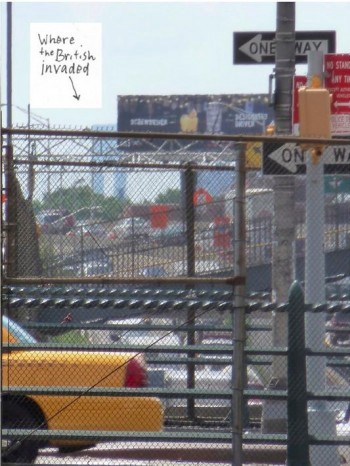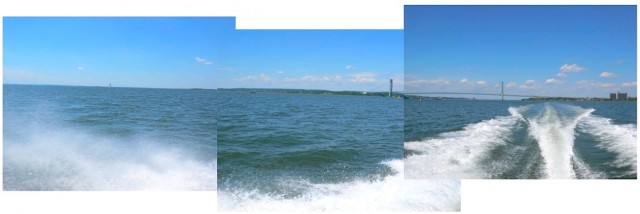The British Invasion... Again: Landing In New York
The British Invasion… Again: Landing In New York
by Robert Sullivan

The British invasion began on this day in 1776. For the next couple weeks, Robert Sullivan will be considering how the trail of the Battle of Brooklyn would pass across modern-day New York.
Say the Revolutionary War had never happened back in 1776. Say the British and the American colonists had been able to keep their relationship patched together for another 236 years, puttering along like an old car. Say things were at last things coming to a boil — perhaps due to some remark made by Bob Costas during the Olympics, or due to a break in the Murdoch phone-hacking scandal. Say the British were at last about to invade. A good way to check in on the invading force from your apartment right now — which assuming the time-space continuum allowed it — would be to watch the MTA’s live bridge cams, specifically the ones set up on the Verrazano-Narrows Bridge, which are spotty and always under repair (like the bridge itself) but eventually would give you some idea of how things were going, invasion-wise.
If you’d been commuting from Staten Island or Jersey yourself this morning, then you would be ahead of the game, seeing the masts of the British ships, the large rowboat landing the soldiers over in Brooklyn, perhaps firing a musket at the occasional stray jet skier. This is assuming the British still had their 18th-century fleet, and assuming, again, that the date is something like 1776/2012. Again, we’re bending time here — seeing both times at once. Gravesend is where they in fact landed on August 22, 1776, and if you consider that the season and the places are constants and you just fudge the time a little, then that’s today. (It was almost out of habit that the British landed in Gravesend it seems, as they’d landed there in 1664, also in August, when they took the town of New Amsterdam from the Dutch.)

The narrows from the water, entering the upper bay.
If you were driving across the Verrazano this morning, you would probably have seen lighter than normal automobile traffic, it being a weekday at the end of summer, but the British military traffic would be heavy and picking up, as they ferried men from the boats to the shore, along the path of the 18th-century equivalent of the Verrazano-Narrows, which was Denyse’s Ferry, a ferry that took travelers between Staten and Long islands, the natural short cut across the harbor. The modern bridge takes its name from this relatively narrow strait of water between Staten Island and Brooklyn. If you were out there this morning, in place of the fleet you would see large container ships moving slowly through the Narrows; waiting in a long line for the pilots who will board and take them into port in Newark or Elizabeth. (You can see their ghosts on the satellite view of the Narrows on Google.) If you’ve ever approached the Narrows in a boat, coming, from, say, Lower Manhattan, you know that the air changes at the Narrows, that suddenly the temperature drops a little, that at that point the smell is less of the harbor and more of the open sea. The Verrazano Narrows is a border, a microclimate threshold, a natural invasion point, it seems.
On August 24, 1776, the Constitutional Gazette would report that the “ministerial troops” had landed “between New-Utrecht and Gravesend on Long Island to the number of 7000 men.” A later report noted that there were a little over 12,000 British “on the Shore by 11 o’Clock.” As far as military logistics go, Brooklyn was a good place to invade; the farms in Brooklyn could feed an army, and the Dutch settlers in the area do not have a political dog in the fight. It was a big landing. The statistic that is invariably mentioned in post-World War II accounts of the 1776 British invasion is this: it was the largest invasion by military forces until D-Day.
For me, imagining a British invasion helps me see the modern harbor. Seeing the harbor is, I feel, a big deal, especially in a place where it is sometimes difficult to see the water. Once I was at a swanky dinner, a fundraiser, during which a number of well-known performers sang sea shanties in Brooklyn, including Gavin Friday, who I think scared a lot of people. At one point one of the singers said, “Do you realize that New York City is a harbor city?” At this, people gasped, in shock at the idea.
Seeing the harbor takes some work. It’s one thing to do it with a map, another to do it in a boat, or even on land — to see the jaws of the so-called New York and New Jersey bight, one jaw the Rockaways, the other Sandy Hook in New Jersey. It’s difficult to imagine that a ship or a fleet sailing from England would, after weeks at sea, somehow spot Sandy Hook, then home to a light house, today home to a lighthouse and the East Coast’s largest nude beach.
It’s kind of wonderful to imagine that a ship would then stop to take on fresh water, in what is today Highlands, New Jersey (“Where the Jersey Shore begins”) and then know to head into to the Lower New York Bay and maybe on a clear day even look into the distance to see the Catskills, a possibility, or so claimed Jasper Danckaerts, a sailor on Henry Hudson’s Half Moon (as noted in John Waldman’s Heartbeats in the Muck). It is, for me, a worthwhile endeavor to think that they would see the tall building at the bottom of Manhattan marking the end of their trip to Manhattan — today the not-finished World Trade Center building, then Trinity Church. This what happens in August, and all through the years, when I see the towers of the Verrazano Bridge. And it happens casually, and when I least expect it, each time I glance one or two of the Verrazano’s towers on the horizon — when I am, for instance, crossing the BQE on foot into Red Hook, or hanging out near the police department’s evidence pier on the shore of Gowanus Bay, or having a drink up high in the Standard Hotel’s harbor view bar, or riding the Staten Island Ferry. The towers are like stakes, pins in the map of time, invitations to see a bigger picture of where we live.
Robert Sullivan is the author of a several books, including Rats, How Not To Get Rich, and the Meadowlands. His newest book My American Revolution will be published out Sept. 4 and is available for preorder.
